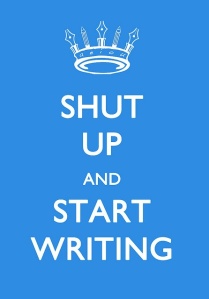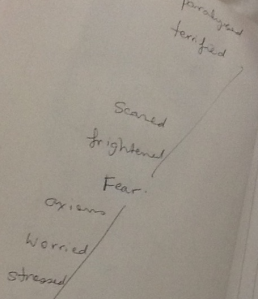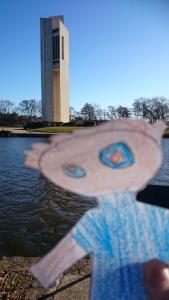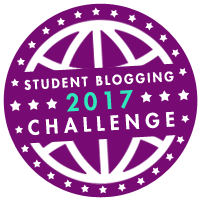Monthly Archives: July 2015
Re-igniting MY Curiosity … Day 3
 The final day has arrived … I’m tired but still looking forward to the thought-provoking day ahead.
The final day has arrived … I’m tired but still looking forward to the thought-provoking day ahead.
Unfortunately I was running just a bit too late to make it in time for the key note being presented by “The Sisters” (Joan Moser and Gail Boushey): “Daily 5: Establish Active, Curious behaviours as the Foundation for Your Classroom Structure to Improve Student Learning.”
I have been reading about Daily 5 through the US section of my PLN on twitter. I knew it is essentially aimed at early years/primary but was interested to see what I could take away and adapt for my junior secondary students.
But you know what …
… sometimes it’s nice to just stop and smell the roses!
I took the half hour I found myself with and sat quietly contemplating what I had seen and heard over the past two days. I started to plan these last two blog posts, I checked out some websites I’d saved for later, and I continued to follow the #EngLit2015 twitter feed.
I made sure I was early to the first workshop of the day: “Internationalising the English Curriculum” by Geoff Piggott.
As I walked in he was handing out playing cards (I do things like that … no explanation … just leave the student guessing) … curiosity aroused … tick!
He talked about the way English as a language has expanded across the globe: About how meaning is different in each kind of English that is spoken. We watched part of a TedTalk about ‘The Danger of the Single Story‘ … about looking at the surface and relying on stereotypes. I say part … nothing like waiting till the audience is engaged and then stopping the video … (have to look that up later!!!) … curiosity aroused … tick?
Then we got to the playing cards: Time for a bit of audience participation. Geoff called it Fishbowl but it was a form of socratic circles. (google will turn up lots but the link will get you started.)
I left wondering about my year 11 English class and how I could get them to see past the single story.
The next keynote by Steve Shann was “Secondary English and our Students’ Lifeworlds: Stories from the Mythpoetic Margins.”
Awesome. Amazing. Enthralling. Like nothing I have seen before.
Steve and his two associates used a performance mode, reading a specifically written story to highlight the issues we face in teaching English in high school. The juxtaposition of the two teachers (Sylvia and Minn) highlighted teaching styles, teaching philosophy, gender/cultural stereotypes, etc. I wondered:
- What verbs dominate and drive your/my unit/term planners?
- How does our own experience of school shape the teacher we become?
- How can we change the pervading notions that unless it’s marked a learning task is not worthwhile; that learning is only for assessment?
After lunch I tried to get into “The Power of an Inquiry Based Approach to Teaching and Learning in the English Classroom” … however the room was already over-crowded when I got there. I attempted to find another session but by this stage most had already started so again I found myself with another half hour of contemplation.
The last session was a workshop: “Programming Creatively for Disengaged Youth: Are You Game?” presented by Ruth Doyle and Damon Eaton.
They presented their unit of work for yr 11 English completely based on and around the concept of games and game development. They clearly linked to every assessment task and learning activity you would expect senior students to complete. They covered everything from the history of games, how games differ across cultures, to the development and promotion of a game by the students. All of this in 18 weeks of teaching!!!
They courageously shared the things that didn’t work well and the things they would change, and generously shared their unit plan. I wondered how might I be able to work in a task or two to interest my disengaged ‘footy’ boys? (The ones who always come late because they would rather continue playing footy!)
… then, it was all over!
We were sitting in the plenary session, watching the hand over from Canberra to Adelaide.
Re-igniting MY Curiosity … Day 2
The opening keynote today: “Ignorance Killed the Cat: What’s Left Out of Literacy Research and Policy, and the Implications for Teachers’ Knowledge and Practice” was presented by Peter Freebody.
It puts things in perspective to realise that “780 million adults worldwide can’t read or write” and that “2/3 of them are women.” Seeing a 4000 year old cuneiform tablet artefact with a note from a parent:
My little son opened his hand and you allowed wisdom to come into it – you showed him the art of writing.
I sit in the privileged space of being able to read and write, AND have the skills to pass this ability on to others.
This left me wondering how do you/I “allow wisdom”in the classroom. How do you/I “attempt to create the conditions in which they can learn?” (Albert Einstein).
We should also be more critical about how much trust we place in the research we are presented with. How do we apply our practical wisdom to the theoretical wisdom we are presented with?
I stayed on in the Royal Theatre for the workshop presentation: “Reading Australia for Secondary Schools”
This was part of the launch strategy for this website which will make it much easier for teachers to choose Australian stories for the classroom. I am a Literature teacher, as well as an English teacher, and I am as guilty as the next person of literary snobbery. I have my favourite classics – written by ‘dead white people’. However, I do believe we have some fantastic Australian literature we should be championing. This website, funded by the copyright agency, has support for teachers across a wide range of text types.
The next keynote: “Responding Creatively: Considerations for Supporting Children as Authors of Digital Multimodal Literary Texts” by Jessica Mantei.
We looked at what students need to do to be able to read literary and non-literary texts. If non-literary print texts are confusing how can readers even begin to navigate online/multimodal texts?
We then looked at some interesting films made by students in response to “The Lost Thing” – a short film and PSB by Shaun Tan. Students used elements such as characters and themes to create their own stories using puppetpals (iPad app). It was good to see some not quite so successful pieces.
I left wondering how I can encourage my students to include more visuals in their work. I would love to do more multimodal work but at the moment resources are a challenge. May be next year, when we go BYOD, I could explore how to over come this challenge.
Dr Noella Mackenzie’s workshop “Nurturing future wordsmiths: A focus on Vocabulary” was a full house. She gave practical activities that could be used across the full spectrum of education to promote passion for wordsmithing (not sure if that is a real word!!!)
 Students need access to the meaning of words used by teachers. We should use ‘big’ words, we should be exposing them to a wider vocabulary but it is no good if they can’t make sense of what we are saying. We don’t need to dumb it down but do need to be aware of how we introduce new words. Telling students to ‘look it up in a dictionary’ is not really a helpful solution. Dictionaries vary in quality and words can have more than one meaning depending on context.
Students need access to the meaning of words used by teachers. We should use ‘big’ words, we should be exposing them to a wider vocabulary but it is no good if they can’t make sense of what we are saying. We don’t need to dumb it down but do need to be aware of how we introduce new words. Telling students to ‘look it up in a dictionary’ is not really a helpful solution. Dictionaries vary in quality and words can have more than one meaning depending on context.
Word clines promote higher order thinking and call on a wide vocabulary to create. Our attempt was brief and possibly inaccurate but promoted lots of discussion about words.
Students can understand spoken language at a higher level than they can write (this is exactly the problem I was having with that senior EAL student I mentioned in yesterday’s post!). We should be reading to them, out loud, every day. This poses a problem for a secondary environment – I began to wonder if instead of the ideal of reading a class novel over time, maybe a complete package each lesson would still achieve the goals of stimulating vocabulary. How could I encourage other staff across subjects to do the same? 10 minutes read aloud in each lesson of the day at my school would give students 40 mins of exposure.
After lunch the keynote I chose was presented by Dr Anita Heiss : “Nurturing creativity while embedding Indigenous Studies into the National Curriculum”
Every time I have heard Anita speak I walk away thinking I’ve learnt so much but actually know so little about Indigenous culture. Today was no different.
We started with an Indigenous IQ Test (a pop quiz of Indigenous culture). I failed dismally, but it proved the point nicely about how easy it is to overlook and build in recognition of successful Indigenous Australians in to the curriculum (let alone the point how ridiculously culturally biased IQ tests really are). I began to wonder about creating a few slides for my games day quizzes to rectify the obvious imbalance and ignorance I was showing.
I have used Austlit and the specialist subset resource BlackWords on and off. It is a resource I am still exploring but has certainly increased my knowledge and confidence in teaching Indigenous Lit (such as “Swallow the Air” by Tara June Winch).
The biggest message I took away is that we need to stop the segregation between Aboriginal History and Australian History …. IT’S ALL AUSTRALIAN HISTORY!! Indigenous studies may well look at the invasion of Australia in 1788 differently to a European perspective but the history of our country started well before the Europeans arrived.
My final session was a workshop I chose as it was specifically aimed at senior students. “The Creative Mind: A Writing Workshop on Responding to Literary Texts in the Senior Secondary Classroom” run by Madeleine Coulombe. It was another packed room (which felt claustrophobic) but we were soon dispossessed of those senses as Madeleine got us do some of the writing tasks she does with students. Using texts as springboards for creative writing forces the students to get to know the texts very well. I particularly liked the activity where students create book covers for imaginary books written on the context (in the Victorian Certificate of Education students connect two specific texts and other text connections to a theme. eg Encountering Conflict.)
I walked away wondering how I can create more time for my students to write? and, more importantly with my particular rabble, how I can get them to realise the value of silent writing?
The day ended with what seriously felt like an intimate fireside chat with Gary Crew and Graeme Base. Lots of anecdotes and some sage advice. I was impressed with Graeme’s passion for championing the importance of his chosen punctuation in his work and will use this as evidence in my own crusade with my students … and, Gary, your secret is safe with us 😉
… and that was just day two!
Re-igniting MY Curiosity
 Tomorrow I will attend the final day of the three day ALEA Conference, Capitalising on Curiosity, in Canberra. I almost didn’t attend this conference. I had started to spiral down into the vortex of negativity that lurks in schools waiting to trap those who are losing focus, energy and inspiration. However, my stars aligned and following a quick conversation with a colleague (who is also my sister), reminiscing about how inspiring and just generally good fun it had been to attend a national conference in Melbourne a few years ago (that time it was ACEC2010) I decided to take the plunge. I am glad I did!
Tomorrow I will attend the final day of the three day ALEA Conference, Capitalising on Curiosity, in Canberra. I almost didn’t attend this conference. I had started to spiral down into the vortex of negativity that lurks in schools waiting to trap those who are losing focus, energy and inspiration. However, my stars aligned and following a quick conversation with a colleague (who is also my sister), reminiscing about how inspiring and just generally good fun it had been to attend a national conference in Melbourne a few years ago (that time it was ACEC2010) I decided to take the plunge. I am glad I did!
There is no way to quantify the value of spending time with like-minded, passionate people in pursuit of knowledge on a single topic – in this case literacy education.
Sitting down to morning tea with a complete stranger on day one, just because we had a spare chair, resulted in an interesting conversation. Between the three of us we covered the range from primary through secondary to tertiary (tafe) but shared a common thread of EAL teaching experiences. Thus morning tea was also a learning opportunity, I walked away with a bit of renewed confidence about how I am attempting to help one of my senior EAL students when I have no formal training in this field.
My first session was a keynote: “Asking Better Questions: the Power of Wondering” with Peter O’Connor. How teachers use questions is a key concern in my school at the moment.
Peter began by talking about how we have such a strong sense of wonder as children which we seem to lose over time. Watching children create and explore imaginary worlds you notice they use all of their senses to unpack questions like ‘What is like to be grown up?’
By creating other worlds we better understand our own”.
However, we seem to lose the sense of wonder, and also the ability to use our senses as we move through school. Here is the first challenge – How do you set up learning environments to promote wonder? Added challenge – in a secondary school? Peter went on to talk about process drama and how he had used it to create a framed story that allowed students the safety to question characters about their behaviour. This got me thinking about a guest speaker from years ago (Stephen Gasperino) who talked about “living the text”. My mind began to fire up about my upcoming novel studies in year 8 and 11 …
- How can I set up some situations where we question the key characters?
- Could I get students to imagine themselves as / take on the persona of the characters?
- Could we set up a QandA or 60 Minutes style interview panel?
The next session was a workshop: “Guiding and Scaffolding Reluctant and/or Struggling MS readers” with Dr. Alison Davis.
This was a bit of low for me. The presentation was good but clearly aimed at upper primary school. However, it did confirm that the strategies my school is currently implementing (John Munro) were heading in the right direction. I walked away from this session wondering about how well note taking is explicitly taught (something my school has only just started to do) and how I can challenge my students to create more visuals as part of their writing.
Next was the keynote given by Gary Crew: “The Teenage Castaway: Nurturing Contemporary Teenage Curiosity into the Anxieties of an Extraordinary 19th Century Literary Fascination”.
A thoroughly entertaining and thought-provoking exploration of the tradition of the Robinson Crusoe / castaway story and how it has evolved over time. One of the things I like about Gary Crew is the challenge he makes in his writing and in his critiques about how much is based on reality and how much is made up. We also explored historical and social context in terms of a critical reading of classics like Robinson Crusoe or The Blue Lagoon. I wondered if Robinson Crusoe reflects the values of 19th Century European culture, what does Twilight say about 21st century societal values?
My final workshop for the day was: “Our patchwork history: Exploring the language of research through literature” presented by Claire Saxby.
This was a great follow up to Gary Crew. Claire is the author of the PSB “My Name is Lizzie Flynn”, a fiction based on a lot of fact and a little known chapter of Australian history. The story of female convicts (in this case a child) and how they developed the skills deemed necessary for survival in the new colony of Australia. An enthralling presentation on the lengths Claire went to in verifying details for the story so that it has historic merit as well as being just a darn good read. The gold at the end of the session was hearing her read the book to us. I have blogged before about the importance of using picture story books in secondary classrooms. I have added Lizzie Flynn to my collection and already began to wonder about how I will introduce this text to my students. We have a knitting club, which the students are keen to expand to include more crafts, this seems like a great opportunity to link past and present via young Lizzie!
… and that was just day one!


